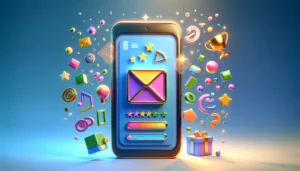
The Tools and Technologies That Can Help Expand Your Email List
Discover the cutting-edge tools and technologies that can revolutionize your email list growth strategy. This article presents valuable insights from industry experts on proven techniques to expand your subscriber base effectively. Learn how to implement targeted campaigns, strategic lead magnets, and innovative technologies to boost your email marketing success.
- Sumo Boosts Email Subscriptions with Targeted Campaigns
- Strategic Lead Magnets Drive List Growth
- Simple Tools and Iteration Yield Email Success
- AI and Heatmaps Enhance Email Marketing Strategy
- Exit-Intent Popups Integrated with Content Strategy
- Smartlead Platform Optimizes Lead Generation Process
- Exit-Intent Technology Captures Relevant Subscribers
- Specific Lead Magnets Automate Qualified Conversations
- SEO-Driven Content Builds Long-Term Email List
- Behavior-Based Popups Improve Email Capture Rates
- Personalization Tools Boost Subscriber Engagement
- Educational Sequences Nurture Long-Term Relationships
- Targeted Forms and Automation Grow Wealth Advisors
- Tailored Content Increases Tech Advisory Subscriptions
- Showroom iPad Captures Emails with Problem-Solving Approach
Sumo Boosts Email Subscriptions with Targeted Campaigns
Out of all the tools I’ve tested over the years to grow our email list, nothing beats Sumo. Unlike most opt-in platforms that limit you to basic popups and standard timing rules, Sumo gave me full control over how and when I engaged visitors. I could build behavior-based triggers that responded to scroll depth, referral source, time on page, and even specific URL paths. That meant I could match the offer to exactly how someone interacted with the site, not just throw a generic form at everyone.
Last month, I launched a campaign using Sumo’s Welcome Mat on a blog post titled, “How to Structure Your PPC Campaigns for Lower CPCs.” The lead magnet was a downloadable checklist that broke down our internal audit process. I configured the Welcome Mat to show only to mobile users who landed on that post through organic Google searches containing phrases like “PPC campaign structure” and “lower CPC strategies.” I excluded returning visitors and anyone who had already subscribed, so we weren’t hitting the same people twice.
That campaign pulled in 2,430 new subscribers in 28 days. The conversion rate was 6.1% across 39,800 pageviews. That same post, using just a Mailchimp sidebar form the month before, brought in 1,012 subscribers from nearly identical traffic volume, putting the old conversion rate at 2.5%. The lift wasn’t subtle. Same offer, same traffic source, but Sumo’s targeting and format more than doubled the response.
 Kevin Heimlich
Kevin Heimlich
Digital Marketing Consultant & Chief Executive Officer, The Ad Firm
Strategic Lead Magnets Drive List Growth
I’ve found that lead magnets strategically placed on high-traffic pages have been our most powerful tool for growing email lists. When we implemented content upgrades like industry-specific white papers and case studies on our SaaS clients’ websites, we saw conversion rates jump from the typical 1-2% to over 8% in some cases.
Qualaroo has been instrumental for our HVAC clients—its user-friendly forms with advanced targeting triggers based on visitor behavior helped us build highly qualified lists by appearing at precisely the right moment in the customer journey. For our own agency, we’ve found Mailbrew particularly valuable for creating curated content digests that maintain high engagement rates.
The real game-changer has been our approach to pricing transparency in SaaS email capture. When we implemented clear pricing models alongside free trial opt-ins (with minimal form fields), we saw a 31% increase in qualified leads for one client. The psychology of “no-risk guarantees” paired with transparent pricing significantly reduced form abandonment.
For B2B clients, we’ve had success with Substack as a specialized tool for monetizing email newsletters with exclusive content. This approach creates a dual benefit—generating direct subscription revenue while simultaneously building a highly engaged email list of industry professionals willing to pay for expertise.
 Ronak Kothari
Ronak Kothari
Owner, Ronkot Design, LLC
Simple Tools and Iteration Yield Email Success
We relied on ConvertKit for list growth. It simplified segmentation and allowed us to build quick automation flows without a steep learning curve. Paired with OptinMonster, we tested pop-ups and inline forms that didn’t annoy users. A/B testing showed us what actually worked, not just what looked good.
We also used Zapier to link forms to our CRM and Google Sheets for manual tagging. No fancy technology was needed. Just clean, reliable connections between platforms.
Our content team wrote lead magnets based on real search intent, not guesses. Each opt-in had a clear payoff: checklist, audit template, or cheat sheet.
Growth wasn’t magic. It was iteration. Create, test, improve. Again and again.
If I had to start over, I’d still pick the same stack. And I’d move faster on split-testing headlines. Most people don’t, and that’s where the gold is.
 Mike Khorev
Mike Khorev
Growth Advisor, Mike Khorev
AI and Heatmaps Enhance Email Marketing Strategy
I’ve found email lead magnets to be absolutely essential for growing our subscriber lists at Celestial Digital Services. We saw a 35% increase in opt-ins after implementing targeted eBooks and exclusive reports that address specific pain points our small business clients face with digital marketing.
Reply.io has been our secret weapon for automating personalized follow-ups. This AI-driven platform allowed us to scale our outreach while maintaining that crucial personalized touch, and the built-in A/B testing helped us refine our messaging to achieve 28% higher open rates compared to our previous manual approach.
HotJar’s heatmaps completely transformed how we design landing pages for our clients’ lead generation campaigns. By visualizing exactly where visitors were clicking (or abandoning), we redesigned our forms and CTAs which boosted conversion rates by 22% across client campaigns. The free tier makes this accessible for even the smallest businesses.
For segmentation, we rely heavily on behavioral triggers based on website activity data. When we implemented abandoned cart reminders and interest-based content sequences for a local bookstore client, their subscriber-to-customer conversion jumped 19%. This approach works because it delivers exactly what prospects are actually interested in, not what we think they want.
 Rodney Moreland
Rodney Moreland
Founder, Celestial Digital Services
Exit-Intent Popups Integrated with Content Strategy
I’ve witnessed firsthand just how impactful having the proper tools can be in building an email list. A game-changer for us has been implementing exit-intent popups in conjunction with content-relevant offers—tools like OptinMonster that integrate directly into our CRM. This combination allows us to capture visitors just as they’re about to exit and offer them something that’s relevant, such as an informative roofing maintenance checklist, which comes off as useful rather than aggressive.
Here’s what made this succeed: integration into an overarching content strategy. We ensured that the content of the email fulfilled the promise of practical tips, seasonal reminders, and special offers that kept subscribers engaged while keeping unsubscribes to a minimum. There’s an artful dance to it: get attention without irritating folks. The takeaway? Integration is as important as the tool itself. When lead-capture tools speak fluently to marketing automation and content strategies, your subscriber list not only grows, it grows filled with quality contacts that want to hear from you.
 Ihor Shulezhko
Ihor Shulezhko
Marketer, Growth Hacker, CMO, Roof MySpace
Smartlead Platform Optimizes Lead Generation Process
Growing our email subscriber list has been a strategic priority, and several key tools have been instrumental in achieving this. First and foremost, our own platform has been central to our growth. It enables us to build hyper-personalized outreach campaigns, automate follow-ups, and track engagement in real-time, ensuring every lead interaction is optimized. Additionally, we’ve leveraged Zapier for smooth automation between our lead generation forms and our platform, ensuring a consistent data flow. By integrating these tools into our broader content and inbound marketing strategy, we’ve created a scalable system that attracts, qualifies, and nurtures leads—growing our list with engaged subscribers who are more likely to convert into loyal customers.
 Vaibhav Namburi
Vaibhav Namburi
Founder, Smartlead.ai
Exit-Intent Technology Captures Relevant Subscribers
The most instrumental tool for growing email lists has been OptinMonster’s Exit-Intent Technology combined with content-specific lead magnets. Instead of generic newsletter signups, we create targeted opt-ins that trigger when visitors show leaving behavior while consuming specific content types.
We’ve integrated this with our content strategy by creating micro-resources that extend the value of whatever page triggered the exit intent. For a financial services client, this approach increased email captures by 35+% because visitors received relevant tools like “retirement calculator” on retirement articles rather than generic newsletter prompts. The integration works because it respects the visitor’s current information journey rather than interrupting it with unrelated offers.
 Jock Breitwieser
Jock Breitwieser
Digital Marketing Strategist, SocialSellinator
Specific Lead Magnets Automate Qualified Conversations
Exit-intent popups from Privy and embedded forms via ConvertKit were crucial for list growth—but the real win came from lead magnets that didn’t feel generic. We offered ultra-specific freebies—like industry swipe files or “steal-this” templates—that matched our blog content. These tools fed into automated welcome sequences that warmed up leads before sales even stepped in. Integration was seamless: more traffic led to more opt-ins, which led to more qualified conversations, all on autopilot.
 Justin Belmont
Justin Belmont
Founder & CEO, Prose
SEO-Driven Content Builds Long-Term Email List
Most marketers won’t hear this, but landing pages are overrated.
Everyone tells you to “build a high-converting funnel,” but they don’t tell you that funnels don’t rank on Google. You switch the ads off and have no traffic, leads, or list.
What actually built our email list—and still builds it to this day—is a content-rich website that ranks on Google and converts visitors without acting like a pushy sales page.
Back in 2014, we built one of our first real sites. It didn’t follow “funnel best practices” and had the following pages: About, Blog, Services, Contact. Multiple actions. Real information. It was the kind of site Google wants to send people to, and it still gets leads today, 10 years later, without spending a cent on ads.
But what turned that SEO traffic into email subscribers was a tiny little widget called vCita. One button and one offer. That’s all.
It popped up with a message:
“Want a free course info pack?”
Simple. Relevant. No pressure.
The visitor would click and drop in their name, email, and phone number. Then, we would auto-send the guide, and our team would follow up with a call. That was the complete system.
We received 5-7 qualified inquiries daily, all organic, and around 25-30% would buy on the first phone call. There were no drip sequences or lead magnets stacked 10 levels deep. It was simply the right message, shown to the right person, at the right time.
Here’s how it integrated into our broader marketing strategy:
We didn’t separate SEO and email capture. We merged them. Our blog posts brought in traffic, the pop-up turned that traffic into leads, the free info pack built trust, and then the sales team followed up to close.
So, if your site is only built to convert, you’ll always be paying for attention. But if your site ranks and converts, you win in the long term.
Today, I see too many people chasing the latest landing page hack while their site collects dust. Meanwhile, a $30/month widget and some good Google rankings built us a 10-year compounding email list that still drives revenue.
Build a site worth visiting and then give them one great reason to leave their email.
 Grace Savage
Grace Savage
Brand & AI Specialist, TradieAgency.com
Behavior-Based Popups Improve Email Capture Rates
As Growth Marketers, on-site behavior-based popups are one of the most effective tools we’ve used to grow email subscriber lists for our clients. We pair these popups with email automation tools that segment new leads in real time.
For example, we’ve used tools that trigger opt-in forms based on scroll depth and time on site, rather than relying on static popups. Behavior-based popups helped us capture attention at key moments and improved the conversion rate. In one case, we saw even a 38% increase in opt-ins simply by switching to scroll-based triggers.
To make this work at scale, we also integrated these tools with our broader CRM and email platforms, tagging new subscribers based on the page they came from. That lets us follow up with tailored welcome sequences or campaign-specific content.
 Afruz Fatulla-zada
Afruz Fatulla-zada
Project Manager | Growth Marketer, Vitanur
Personalization Tools Boost Subscriber Engagement
We’ve grown our email subscriber list by using a mix of innovative tools and strategies. Mailchimp and HubSpot helped us with email automation, organizing contacts, and tracking engagement. We also used lead magnets like free guides, webinars, and exclusive content, which we promoted through targeted social media campaigns.
We integrated these tools into our marketing strategy to focus on audience personalization and engagement. For example, we used HubSpot’s CRM to understand what our subscribers like, so our emails stayed relevant and valuable. By automating the process, we saved time while still turning leads into loyal subscribers. This mix of innovative tools and good planning has been essential in successfully growing our email subscriber base.
 Robbert Bink
Robbert Bink
Founder, Crypto Recovery Services
Educational Sequences Nurture Long-Term Relationships
We’ve always believed that education should start long before the admissions process. Our most effective tool has been Drip, which allows us to segment students and families by academic interest, application stage, and geography. We create automated email sequences based on timelines, early high school preparation, summer enrichment programs, or final-year application checklists.
We also sync data from our online bootcamps and webinars. So, if a student attended a session on Ivy League interview preparation, they’re funneled into a content track that includes mock interview scripts, alumni advice, and tailored calls to action. These sequences are long, sometimes 8-10 emails, but we design them to unfold like a curriculum, not a sales funnel. This approach nurtures trust, which converts to long-term coaching relationships.
 Joel Butterly
Joel Butterly
CEO & Founder, InGenius Prep
Targeted Forms and Automation Grow Wealth Advisors
I have found that using a combination of ConvertKit and LinkedIn Lead Gen Forms has been life-changing in growing our email subscriber list. ConvertKit’s intuitive automation allows us to create targeted email sequences that nurture leads, such as first-time homebuyers or property investors, by delivering tailored content like our Borrowing Power Calculator results or stamp duty guides specific to South Australia. We integrated these tools into our marketing strategy by embedding ConvertKit sign-up forms on our website’s high-traffic pages, like the free strategy session landing page, which captures leads directly from interested clients.
LinkedIn Lead Gen Forms complement this by targeting professionals interested in property investment, using precise ad campaigns to offer exclusive guides on bridging finance. These forms sync seamlessly with ConvertKit, ensuring leads flow directly into segmented lists for personalized follow-ups. This approach aligns with our client-focused ethos, providing value-driven content that builds trust and encourages subscriptions. We refine our campaigns to focus on what resonates most with our audience, like practical mortgage tips, by analyzing open rates and click-through data in ConvertKit.
 Austin Rulfs
Austin Rulfs
Founder / Property & Finance Specialist, Zanda Wealth
Tailored Content Increases Tech Advisory Subscriptions
We’ve used Mailchimp and HubSpot to grow our email subscriber list steadily over the years. Mailchimp helped us get started with its easy design tools and automation features. We used it for simple newsletters and follow-up sequences. As our client base grew, we shifted more towards HubSpot. HubSpot’s segmentation and CRM integration allowed us to send more targeted emails. We saw a 30% increase in open rates once we started tailoring messages to industry-specific groups, like CPA firms and law offices.
AI-driven tools like Phrasee made a difference too. We tested AI-generated subject lines for our cybersecurity tips newsletter. Open rates jumped nearly 20% after just a few campaigns. Dynamic content helped us send the right message to the right people. For example, Florida clients received hurricane-prep checklists while Boston clients got winter storm readiness tips. Those small changes made the emails feel more relevant, and that led to better engagement.
Email marketing never stands alone. We paired it with content from our blog, webinars, and IT tip sheets. Elmo Taddeo once suggested offering a free ransomware checklist as a lead magnet—our list grew by over 500 subscribers in two weeks. We also ran Facebook and LinkedIn ads driving traffic to sign-up pages. Every campaign was tracked in HubSpot, so we always knew what worked. The key is making each tool part of a bigger system, not just using it because it’s trendy. Know your audience, stay consistent, and always offer something valuable.
 Konrad Martin
Konrad Martin
CEO, Tech Advisors
Showroom iPad Captures Emails with Problem-Solving Approach
You can try a wall-mounted iPad in the showroom, which can do more than any pop-up or social media giveaway. It can run a simple form with only two fields, asking new visitors what space in their home is bothering them the most. It takes under 10 seconds and feels personal. It turns out that when someone enters “pantry chaos,” they are already interested in receiving the next email. We just had to build that into the rhythm, and it snowballed. For every 10 customers that walk in, at least 6 enter their information.
As it turns out, the key is making the sign-up feel like the first step in fixing a problem, not just subscribing to unwanted content. Follow-up emails contain real examples based on what they wrote. For people frustrated with disorganized garages, they receive a photo of a tidy three-wall storage installation we completed, with actual dimensions listed. That made open rates increase from 31% to 53% on those emails. Essentially, if the content feels tailored to their specific problem, they remain interested.
 John Washer
John Washer
Owner, Cabinets Plus



